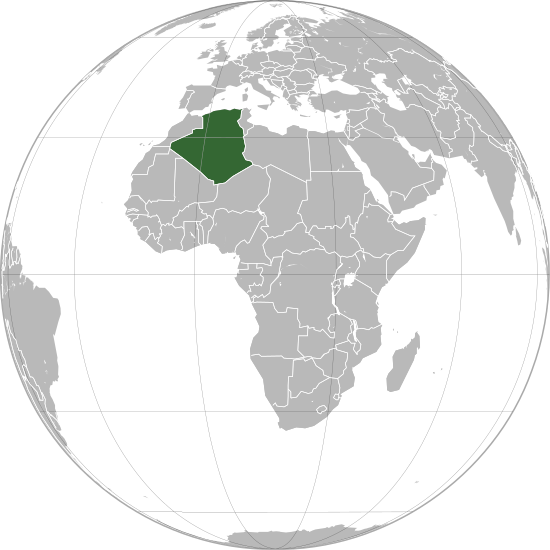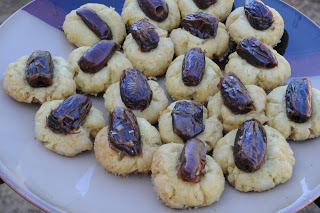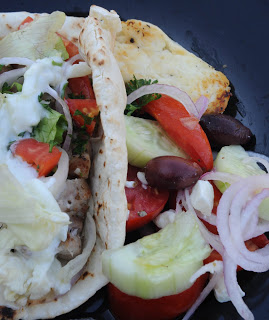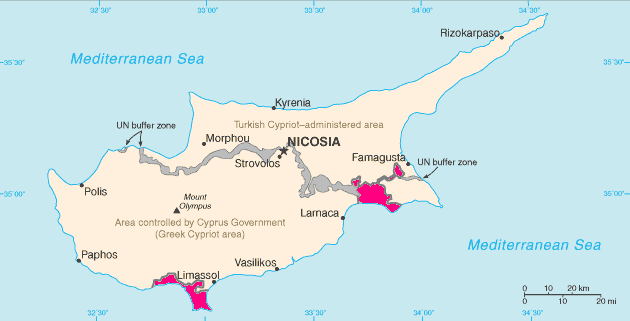 |
| Recipes from Algeria |
First the usual background stuff:
Algeria. A country in North Africa, in the same vicinity as Libya and Morocco. Algeria isn't really on the international radar, so it may surprise you to hear that--geographically speaking--it is the largest country in Africa as well as the 10th largest country in the world.
There are 36.3 million people in Algeria, so recipes aren't hard to find. In fact, Algeria has its own celebrity chef: Farid Zadi, who is kind of like the Gordon Ramsay of North Africa. Zadi has a website, which you can visit here: http://www.chefzadi.com. Unfortunately, his website is far less impressive than his cooking skills apparently are--I poked around on it for about 20 minutes without finding a single recipe, despite links with titles like "Algerian Cookbook" and "Tagine Recipes." I don't doubt that Chef Zadi has many skills, but web design ain't one of them.
I have way too many kids to waste more than 20 minutes on any pointless endeavor, but I did think that at least one of my Algerian recipes should come from Algeria's most famous chef. The one thing I did discover is that Zadi had a few recipes printed in some of the big food magazines, so I went to epicurious.com and did a search for his name. Viola! I hit on my first recipe: Chicken Tagine with Apricots and Spiced Pine Nuts. Here are the ingredients:
For the tagine
- 1 whole chicken (I used a grill pack)
- 2 tablespoons extra-virgin olive oil, divided
- 3 large shallots, finely chopped
- 1 tablespoon unsalted butter
- 2 garlic cloves, minced or pressed
- 1 tablespoon peeled, grated ginger
- 1/4 teaspoon turmeric
- 1/4 teaspoon sweet paprika (I used Hungarian, don't substitute regular paprika)
- Pinch of saffron threads (optional)
- 1 cup water
- 2 tablespoons blood-orange preserves or bitter-orange marmalade
- 1 (2-inch) cinnamon stick
- 1 thyme sprig
- 2 cilantro sprigs
- 6 dried apricots, chopped
- 1 tablespoon finely chopped cilantro or flat-leaf parsley
For the spiced pine nuts
- 1 tablespoon olive oil
- 1/4 cup pine nuts
- 1/4 teaspoon turmeric
- 1/4 teaspoon sweet paprika
- Pinch of cayenne (optional)
Two separate bits of information I gleaned during my search were these: 1) Algerians hardly ever eat a meal without bread and 2) couscous is the national dish of Algeria. So my next dish is an Algerian flatbread, or kisra (from RecipesCal):
- 2 cups semolina flour
- 1 tbsp salt
- 1/4 cup olive oil
- 1 cup water
(Please note that this is not the recipe I used, for reasons which will become clear to you later in this entry).
- 2 tbsp olive oil
- 1 medium onion, chopped
- 8 oz mushrooms, sliced
- 1 grated carrot
- 2 cloves garlic, minced or pressed
- 1/2 tsp cumin
- 1/2 tsp ground coriander seeds
- Zest of 1 lemon
- Juice of 1 lemon
- 1/2 cup raisins
- 1 1/4 cups of chicken stock
- 1 cup couscous
So, starting with the tagine, here are my disclaimers:
A tagine, if you haven't heard of such a thing, is a dish named for the pot it is cooked in. The tagine pot, in turn, is an earthenware unit with a base that holds the food and a top shaped a little like a chimney. The pot is designed to return condensation to the food, which results in a very moist dish.
Now, if you are cooking Algeria and you want to be super-authentic, you can pick up a tagine on Amazon.com for about 60 bucks. I, as you know, am not that devoted. I would rather just admit that my dish is not 100% authentic and move on from there, rather than spend the equivalent of three boxes of diapers on something I'm not likely to cook with more than occasionally.
In my defense, Zadi doesn't say in his recipe that you should use a tagine, though I bet he's thinking it. Anyway, his dish starts simply enough, with the ritual browning of the chicken.
Zadi calls for a whole chicken, which you cut up yourself. Personally, I have a grocery store that does that for me so I never bothered to learn how to cut up a chicken. That just sounds like way too much work. Way too much gross work. So I just used a grill pack, which contains two breasts and four leg joints, since I have three kids who will gladly box each other for two drumsticks.
So first brown the chicken in olive oil, then transfer it to a plate and keep it warm.
 |
| Browned chicken, waiting for the next step. |
Next, finely chop the shallots.
 |
| Shallots, the onion that wants to be garlic. |
 | ||
| Finely chopped shallots. |
Zadi says to then melt the butter and sauté the shallots in a separate pan, but I didn't see the point of having to wash up another pan, so I just poured off some of the oil and melted the butter in the same pan, deglazing as I stirred.
 |
| Sauteing the shallots. |
When the shallots are soft (in about 8 to 10 minutes), add the garlic, ginger, turmeric and paprika. Continue to stir for two to three minutes, then return the chicken to the pot, making sure the shallot mixture coats the front and back of each piece.
 |
| Coat each piece of chicken with the shallots. |
Add the water and a half teaspoon of salt. If you are fabulously wealthy and can afford to buy like three strands of safforn for 15 or 20 bucks, here's where you add it (you can probably guess that I left it out). Bring to a boil, then reduce heat to a simmer and cover. Simmer for 30 minutes. Now is a good time to move on to the bread.
This version of kisra is made with semolina flour, though Zadi does have a version on Epicurious that is made with all-purpose, in case you can't find semolina. I live in hodunk nowhere and I was able to find this bag of semolina in the baking section of my local grocery store, so I don't think it's too tough to find.
 |
| Semolina is often used to make pasta. |
Now here's where disaster set in. The recipe I used (as opposed to the one copied above) called for 3/4 cup of oil. Then on top of that, it called for a whole cup of water, which was just craziness. I faithfully and stupidly tried to follow the recipe. I got about a half cup of water into the mix and realized there was no way it was ever going to become a "soft, pliable dough" so I quit and hoped for the best.
 |
| This is going to become bread? I'm feeling skeptical. |
Next, flatten the bread out and put it in a frying pan--this bread bakes over a flame instead of in the oven.Yours should look a lot less oily than this one. Heat over a medium flame until golden on the bottom. Because mine was so oily, it took a while to get to that point.
 |
| My kisra. Sad. |
Now back to the chicken. Take the lid off your pot, then turn the chicken pieces over. Add the marmalade (unless you actually managed to find blood orange preserves), the chopped apricots, and the cinnamon stick, thyme and cilantro sprigs. Cover the pot again and simmer for another 10 minutes.
While the chicken is cooking, move on to the pine nuts. This part is easy. Just heat a small amount of oil in a little pot, then add the pine nuts, turmeric, paprika, and cayenne. It will only take one or two minutes for the nuts to start to brown, so watch carefully. You don't want to burn them. When they're done, transfer to a small plate or bowl.
 |
| Browning the pine nuts. |
Here's where I went back to my bread. I could see that turning it over was going to be a problem, based on the way it tried to fall apart when I lifted the edge to see how well it was cooking. I tried to slide it onto a plate, then flip it quickly back into the pan. Here's what happened:
 |
| Oh, the horror! |
Yes, my kisra exploded. Fortunately I had a second ball ready to go in my bowl. I tried to save it by adding more semolina (a lot more) and some all purpose flour, hoping it would stay together. While this one was cooking, I started on the couscous. In retrospect, I should have started on the couscous during the chicken's 30 minute cooking interval, because none of these dishes were ready at the same time.
So for the couscous, slice the mushrooms, chop the onions and grate the carrots (I prefer grated carrots, you could also chop them). Heat the oil in a large pain and saute until the vegetables soften.
 |
| Saute the vegetables. |
Next add the spices, the couscous, the lemon zest and the raisins. Stir until everything is well incorporated, then add the stock and the lemon juice. Simmer for three minutes, then cover and remove from the heat source. Let stand for five minutes.
 |
| Oh couscous, how I do love you. |
Your chicken should be just about ready. To finish, take the chicken pieces out of the pan and keep them someplace warm. The sauce at the bottom of the pan will probably still be quite thin, so crank up the heat and cook at a rolling boil until it has reduced to a thick sauce.
 |
| Reducing the sauce. |
When the sauce is nice and thick, take it off the heat. Transfer the chicken to plates and pour the sauce over, then sprinkle with the pine nuts.
 |
| Oh my gosh, does this look heavenly or what? |
Yes, there is the kisra, or the substance that is pretending to be kisra. Please let me know if you had better luck with the recipe I ended up posting. Actually my version didn't taste too bad, Martin described it as "a big piece of shortcrust pastry." I thought it was a little bit like that, with a cornbread like texture. It did taste pretty good.
The chicken and the couscous stole the show, though. Both were seriously yummy. I mean really, really yummy. If I lived in Algeria, I would be fat. This was good food.
My kids stayed away from the sauce (they are insane) but they enjoyed the chicken, and Hailey ate more of the bread than anyone. No one under then age of seven went anywhere near the couscous ("Ew! Mushrooms!") Oh well, more for me.
Next week: American Samoa.




















































